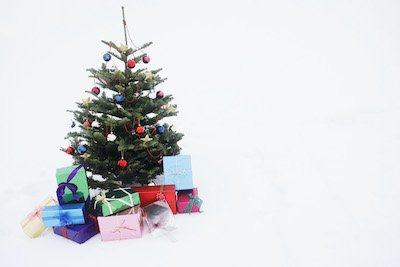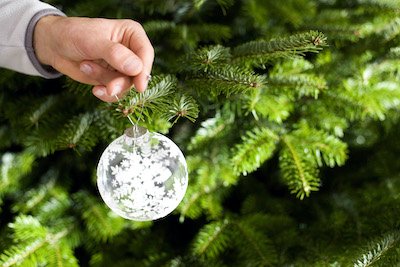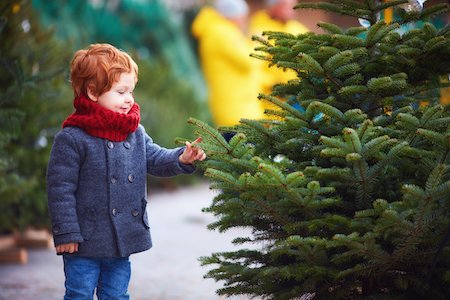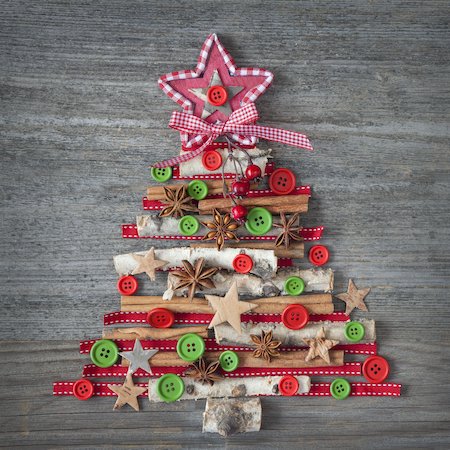The Most Eco-Friendly Christmas Tree
If you’re trying to make your Christmas more sustainable, you might be looking at your Christmas tree and wondering if you’re making the eco-friendly choice. Learn more about the environmental impacts of both real and artificial Christmas trees so you can select the most eco-friendly Christmas tree.
The Debate Over an Eco-Friendly Christmas Tree
Every year, millions of people will put a Christmas tree in their home to celebrate the holidays. Some trees will be real, and some will be artificial.
If you’re trying to live a more eco-friendly lifestyle, you might be having an inner debate this year. Is it more eco-friendly to cut down a live tree that you’ll eventually throw away, or is it better to buy an artificial tree that you can use again and again?
While you always hear that reusable is better than disposable when it comes to the environment, the answer to the most eco-friendly Christmas tree question might surprise you.
Related: Where to Get the Best Tree-Free Christmas Cards
Artificial Christmas Trees


Artificial Christmas trees are made from metal and plastic, which means they take a lot of resources and energy to produce. Additionally, it’s almost impossible to recycle an artificial Christmas tree.
Many artificial trees are also made with polyvinyl chloride (PVC), which is a known carcinogen and one of the most environmentally damaging types of petroleum-derived plastic.
If that wasn’t bad enough, lead is often used as a stabilizer in PVC, which means your fake Christmas tree may be shedding lead dust on your Christmas presents. And that’s certainly not something you want young children exposed to.
What’s even scarier is that lead isn’t just found on fake Christmas trees. One study of 10 store-bought face paints discovered lead in all of them, which is why I always make easy homemade natural face paint.
China manufactures the majority of fake Christmas trees. This means you also have to figure in the carbon footprint of shipping the tree to your country.
According to a study done by the New York Times, you need to reuse your artificial Christmas tree 10 to 20 years to minimize its impact on the environment.
Real Christmas Trees


Much like the fruit and vegetables we eat, real Christmas trees are grown as a crop with the purpose of being cut down. To help keep their business going and make sure they always have healthy trees, Christmas tree farmers typically plant 4 or 5 new trees for every one they cut.
It takes around 8 to 10 years for trees to reach an acceptable height for selling. During that time, they provide a habitat for wildlife. Plus, the soil they’re growing in can actually absorb about 10 times as much carbon as the actual tree.
To help make your real Christmas tree even more environmentally friendly, try to buy from your local tree farm instead of a corner lot or big box store.
When you buy from a local tree farm, you’re cutting back on carbon emissions from long-distance transportation and contributing to your local economy.
When the holidays are over, you have several ways you can recycle your Christmas tree.
If you have the capabilities, mulch the tree on your property so you can use it in your garden and flower beds when spring comes. This creates a sustainable and closed-loop cycle that makes as little waste as possible.
If that’s not an option, check with your local community. Many towns and cities have a curbside tree recycling program. When they collect the tree, they’ll turn it into mulch or compost to use around the community.
Live Christmas Trees


If you really want to make your Christmas tree as eco-friendly as possible, buy one with an attached root ball. When Christmas is over, you can replant the tree and let it continue to absorb carbon dioxide, produce oxygen, and provide a home for animals.
If you plan on buying a living tree, look for one that has a well-developed root ball and appears lively and healthy. Also, water it well through the holidays. This will give it the best chance for survival after it’s replanted.
Additionally, if you live in a cold climate, dig the hole for the tree in the fall before the ground freezes and cover it with mulch. By doing so, the hole will be ready when it’s time to plant your tree.
Other Eco-Friendly Christmas Tree Options
Real or artificial Christmas trees aren’t your only options. With a little creativity, you can come up a variety of other ideas that will make your holiday fun and sustainable at the same time!
Wooden Christmas Tree
A wooden Christmas tree is an option that has been growing in popularity over the years. There are plenty of different styles available, so you can easily find one you like.
Something like this rustic wood Christmas tree looks cute with lights wrapped around it and has plenty of space underneath to stack your Christmas presents.
If you have a lot of decorations you want to display, this wooden eco Christmas tree has numerous branches that are perfectly designed for displaying every ornament.
Wooden Christmas trees offer plenty of advantages. First, since they’re not made from plastic, you don’t have to worry about them shedding lead dust or other harmful chemicals.
Additionally, many wooden Christmas can disassemble into small, flat sections so they’re incredibly easy to store when the holidays are over.
Thrift a Christmas Tree
If getting an artificial tree is the only option that will work for you, consider checking your local thrift stores for a previously owned tree.
Not only is a used Christmas tree considerably cheaper than a new one, but a thrifted tree also doesn’t require the use of any additional resources, which makes it a great eco-friendly option.
Rent a Christmas Tree
Although this isn’t an option in every area, some businesses do offer Christmas tree rentals. They’ll deliver a tree of your choice to your doorstep before the holidays, and then take it away when the holidays are over.
Some companies only offer artificial trees, while others offer real or artificial trees. You can search for Christmas tree rentals in your area to see if you have any local companies available.
DIY Christmas Tree


Making a Christmas tree using items you already have around the house is a fantastic way to celebrate a zero waste Christmas.
If you’re looking for a great project for the kids, consider gathering sticks in various lengths that they can string together in the shape of a tree. You can then hang lights and ornaments on the sticks for a festive and natural look.
A felt Christmas tree is an excellent and safe idea for households with pets and small children. Simply cut out a tree shape from a large piece of green felt. Then use other colors of felt to make ornaments, lights, and other decorations.
Since felt sticks to itself, you can hang the decorations anywhere you want on the tree. You can also redecorate as many times as you want throughout the entire holiday season!
The Best Eco-Friendly Christmas Tree Decorations
Once you have your eco-friendly Christmas tree, it’s time to start decorating it! To make your holiday as sustainable as possible, consider what type of eco-friendly Christmas tree decorations you can use.
Most traditional decorations, such as lights, ornaments, and garlands, are made almost entirely out of cheap plastic. Plus, just like artificial Christmas trees, they’re made in another country and shipped to stores in your country.
To have a truly eco-friendly Christmas tree, look for locally made or homemade plastic-free Christmas decorations.
Eco-Friendly Christmas Lights
Unfortunately, it’s pretty much impossible to find Christmas lights that don’t contain some amount of plastic.
The most eco-friendly lights are the ones you already own. If you have a string with some burned out bulbs, try replacing the bulbs before throwing away the entire string.
If you don’t have any lights, or the lights you currently have are broken beyond repair, choose LED lights instead of traditional incandescent lights. Not only will a string of LED Christmas lights last longer, but it will also help you save money by using less energy than traditional lights.
Eco-Friendly Christmas Ornaments
The best way to find sustainable ornaments is to ask family members if they have any they’re not using. You can also go to your local thrift store to look for ornaments.
If you’re shopping for locally made Christmas ornaments, try to find ones made from glass or wood. Not only are these some of the most sustainable materials available, but they also help make your Christmas tree look naturally beautiful.
Etsy is another good place to look for eco-friendly Christmas ornaments. You’ll find a variety of ornaments in a style sure to match your tastes.
To make your own homemade Christmas ornaments, look for items around your house that you can use. Good options include paper, cinnamon sticks, dried fruit, and dried flowers.
Eco-Friendly Christmas Garland


That shiny tinsel garland might look pretty, but once again, it’s made from PVC coated with a metallic finish.
Fortunately, there are plenty of lovely DIY garland options you can use to decorate your tree. Best of all, making homemade garland isn’t hard to do!
Consider something classic like stringing together popcorn and dried cranberries. Other options include pinecones, dried flowers, dried fruit, and eucalyptus. In fact, there are so many options available, you can easily create something that’s uniquely perfect for your tree.
Plus, since you use biodegradable materials to make your garlands, you can simply toss them in your compost bin when they reach the end of their useful life.
The Bottom Line on Eco-Friendly Christmas Trees
OK, that’s a lot of information to digest. At the end of the day, here’s the bottom line in the eco-friendly Christmas tree debate.
Getting a live Christmas tree with the root ball attached is by far the most eco-friendly Christmas tree.
If you can’t get a tree with an attached root ball, getting a live Christmas tree is more eco-friendly than getting an artificial Christmas tree. Or consider one of the fun DIY options for making your own unique Christmas tree!
If you need to get an artificial Christmas tree, look for one that’s made in the country you live in, not made from PVC, and use it for at least 20 years.
Plus, don’t forget to check out these outstanding posts that can help you make your holiday as sustainable and eco-friendly as possible:
More Eco-Friendly Holiday Tips
If you enjoyed this article about the most eco-friendly Christmas tree, make sure you check out some of our other popular posts so you can make all of your holidays more sustainable:







Leave a Reply